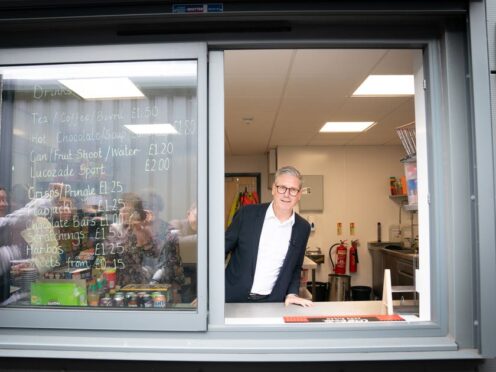
Labour is on course to win around 484 seats in Thursday’s General Election – more than it did when Tony Blair took office in 1997, according to a poll unveiled 36 hours before voting begins.
Survation pollsters quizzed 34,558 respondents online and by phone between June 15 and July 2, and have said a Labour landslide is “99% certain”.
Prominent Conservative figures look set to lose their seats, including Chancellor Jeremy Hunt, Defence Secretary Grant Shapps and Education Secretary Gillian Keegan.
It comes after Labour leader Sir Keir Starmer and Conservative Prime Minister Rishi Sunak found common ground on Tuesday’s campaign trail, with both party leaders warning “every vote” will count.
Using the MRP poll data, which looks at vote share at both national and constituency levels, Survation has said it is almost certain Labour will secure more than 418 seats – the number which New Labour campaigners took in the landslide victory 27 years ago.
“The Conservative Party is virtually certain to win a lower share of the vote than at any past general election,” Survation pollsters wrote in their analysis.
The Tories are tussling with the Liberal Democrats for second place.
According to the model, the Conservatives could win between 34 and 99 seats – an average of 64 – while the Liberal Democrats are set to take between 49 and 73 with an average of 61.
Labour’s best-case scenario is a 517-seat victory, with 447 seats at the “lower end” and a 484-seat average.
Mr Sunak is set to keep a seat in the House of Commons, with a 99% win probability in the Richmond and Northallerton seat, North Yorkshire.

His deputy Oliver Dowden is also set to win in Hertsmere, Hertfordshire, where he has an 84% probability of keeping the seat against Labour rival and former Googlebox star Josh Tapper.
But the probability of Mr Hunt winning in Godalming and Ash, Surrey, is just 5%, with the Liberal Democrats’ Paul Follows at 95%.
Ms Keegan, standing in the Sussex cathedral city of Chichester, is also set to lose to her Lib Dem rival Jess Brown-Fuller.
Labour candidates are also expected to win against other prominent Conservatives including Commons Leader Penny Mordaunt in Portsmouth North, Mr Shapps in Welwyn Hatfield (Hertfordshire), and party chair Richard Holden in Basildon and Billericay (Essex).
“The Conservatives have been under pressure from both the Liberal Democrats and Labour in their heartlands in the South and East of England,” the pollsters added.
“We are projecting many of these ‘blue wall’ seats – defined as constituencies the Conservatives currently hold where a majority are estimated to have voted to Remain in 2016 and the proportion of graduates is above the national average – to change hands on Thursday.
“Of these 52 seats, our estimates suggest the Conservatives will hold just 10.”
In the so-called “red wall”, Survation estimates Labour has a 100% probability of winning in the Leigh area of Greater Manchester, five years after voters turned away from the party for the first time since 1922.
Labour will also almost certainly win Redcar, according to the figures, where the Prime Minister launched his battle bus earlier on the campaign trail.

The Green Party has outperformed its rival parties in two seats – Brighton Pavilion and West Worcestershire.
Reform UK is ahead in a single seat – the Essex seaside constituency of Clacton which party leader Nigel Farage is contesting, where his probability of winning is around 95%.
In Boston and Skegness, Lincolnshire, the party’s Richard Tice is in a close battle with the Conservatives’ Matt Warman.

Survation has put Reform UK’s vote share at a model average 12.2% – against 42.3% for Labour, 22.8% for the Conservatives, and 11.4% for the Liberal Democrats.
On the campaign trail in Banbury, Oxfordshire, Mr Sunak said: “In spite of what some people want others to believe, that it’s all a foregone conclusion, every vote matters.
“Every vote matters, particularly if you want to prevent a Labour supermajority, you want your taxes cut and your pension protected. The only way to do that is to vote Conservative.”
In Derbyshire, Sir Keir said: “People are saying the polls predict the future – they don’t predict the future, every single vote counts, every single vote has to be earned and in places like this it’ll probably go down to a few hundred either way and therefore the worst thing for people who want change is to think ‘job done’ and ‘we don’t need to vote because there’s going to be a majority in any event’. It isn’t job done.”

Enjoy the convenience of having The Sunday Post delivered as a digital ePaper straight to your smartphone, tablet or computer.
Subscribe for only £5.49 a month and enjoy all the benefits of the printed paper as a digital replica.
Subscribe